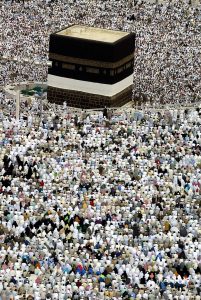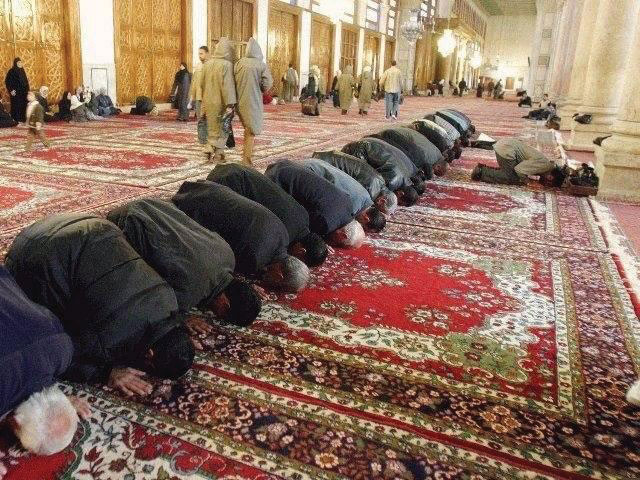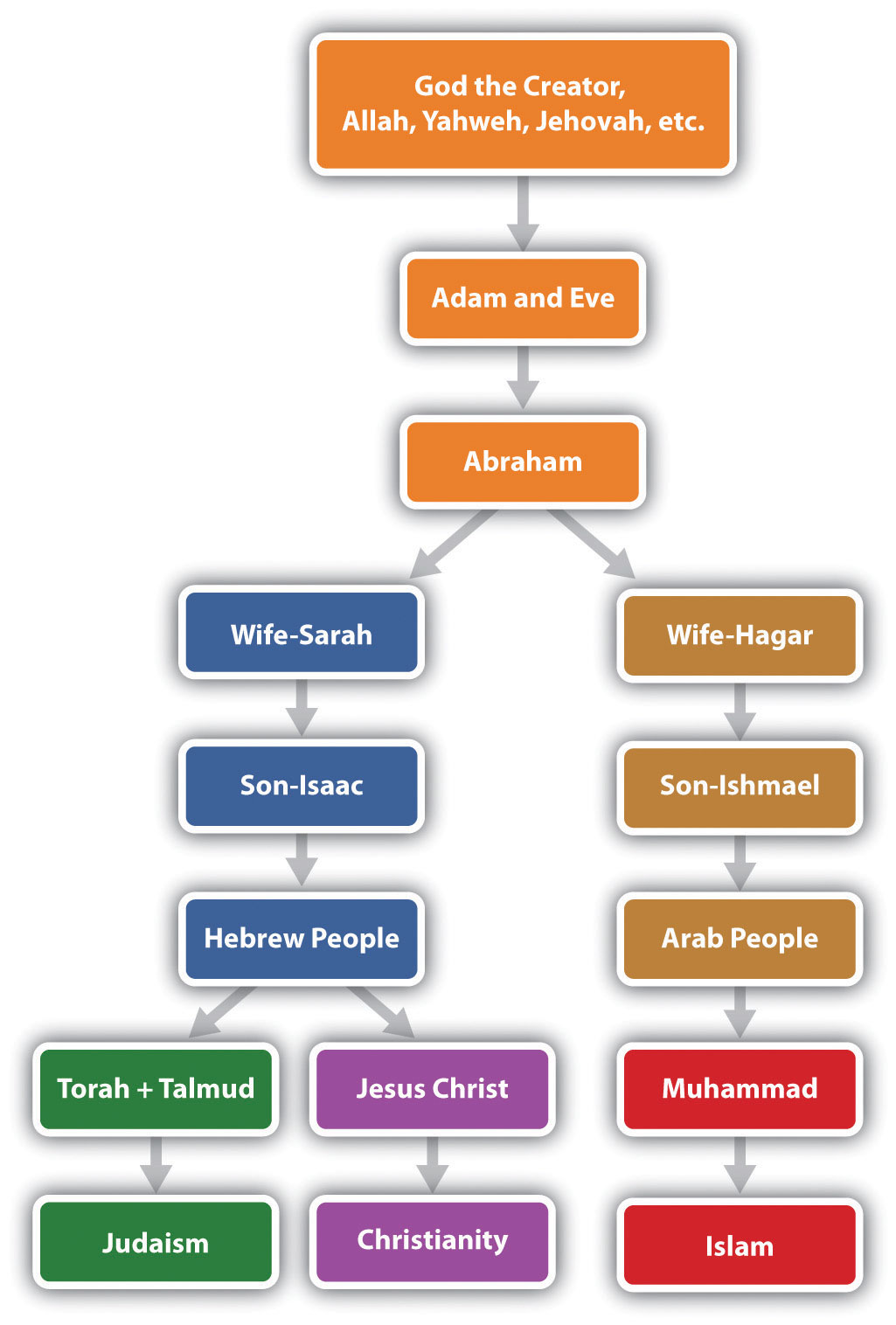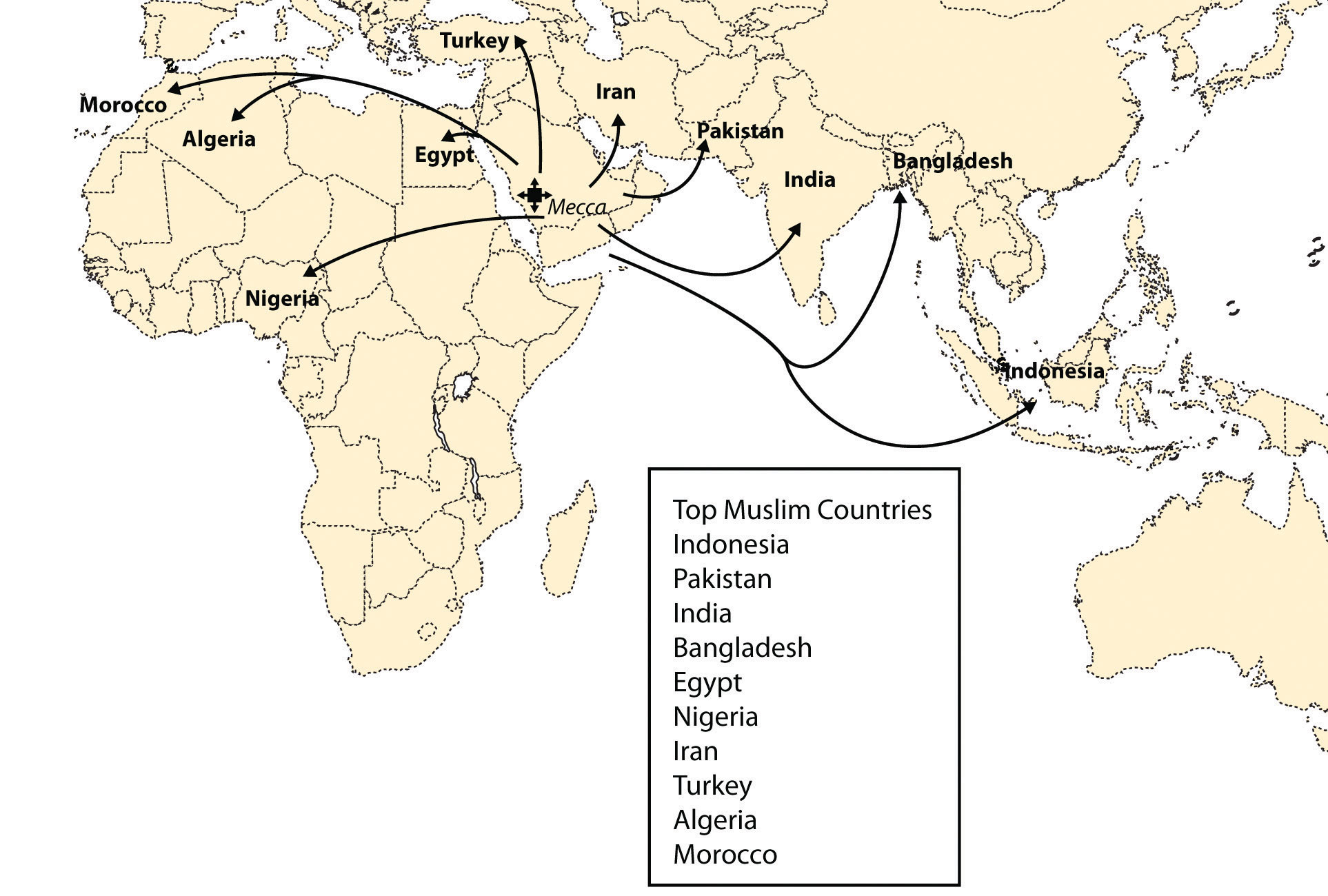8.2 Muhammad and Islam
Learning Objectives
- Summarize the early life of Muhammad and the origins of Islam.
- Analyze the differences and similarities among the three main monotheistic religions.
- Explain the process of spatial diffusion and the various forms it may represent.
- Outline the main divisions of Islam and the approximate percentages of the followers of each division.
- Explain how Islamic fundamentalism influences the debate between a religious state and a secular state.

Located in the mountains of western Saudi Arabia, the city of Mecca (also spelled Makkah) began as an early trade center for the region and a hub for camel caravans trading throughout Southwest Asia and North Africa. Mecca is about forty-five miles from the Red Sea coast at an elevation of 531 feet. South of Mecca, the mountains reach more than 7,200 feet in elevation. According to Islamic tradition, the patriarch Abraham came to Mecca with his Egyptian wife Hagar and their son Ishmael more than two thousand years before the birth of the prophet Muhammad (born 571 CE). When Hagar died, Abraham and Ishmael built the Kaaba (or Ka‘ba), a rectangular shrine that included a special stone, in Mecca. The shrine was destined to become one of the holiest sites for nomadic groups in Arabia. Abraham later died in Palestine in what is now the country of Israel. Centuries after Abraham’s death, the Kaaba and the rituals associated with it deteriorated and mixed with other local traditions.
The Prophet Muhammad
Muhammad was born in Mecca 570 years after the birth of Christ and about 100 years after the fall of the Roman Empire. Since he was an orphan, he grew up in the household of his paternal uncle. In his mid-twenties, he married Khadijah (died 619 CE in Mecca), a wealthy merchant of Mecca and a widow many years his senior. She employed Muhammad to manage her trade caravans and, subsequently impressed by Muhammad’s honesty and intelligence, offered him marriage. Muhammad continued to lead camel caravans of his wife and became a highly regarded and respected member of his community.
The traditional groups that traded in Mecca held many different religious beliefs. The city was a forum for the many vices and activities associated with trade, travel, and metropolitan business. Tradition states that when Muhammad was roughly forty (C. 610 CE), he began having visions and hearing voices. Searching for clarity, he would often seek the solitude of Mount Hira near Mecca, where he would meditate. On one of these occasions, the Archangel Gabriel (Jibra’il in Arabic) appeared to him and instructed him to recite “in the name of [your] lord.” This was the first of many revelations that became the basis of the Qur’an, the holy book of Islam. These early revelations pointed to the existence of a single God, contradicting the polytheistic beliefs of the pre-Islamic Arabian Peninsula. According to tradition, Muhammad was illiterate; his supporters wrote down his words and compiled them into the Koran (Qur’an). After the holy Qur’an, the sayings of the Prophet (“hadith”) and descriptions of his way of life (“Sunna”) are the most important texts of the Muslim faith.
Muhammad was the founder of the new religion, which he called Islam. The Arabic term Islam, literally “submission,” represents the fundamental religious idea of Islam—that the believer (Muslim) submits to the will of Allah (in Arabic, God). Allah is viewed as the sole creator, sustainer, and restorer of the world.
After Muhammad returned to Mecca and related his visions and Allah’s words from the angel Gabriel, he began to speak out against the society’s vices and many gods. He spoke out against gambling and drinking alcohol. He advocated for the caretaking of widows and orphans. He also preached regarding family and community. His message was not well received and Muhammad began to face strong opposition and difficulties in Mecca. In 622 CE, the people of Mecca forced Muhammad to migrate to the safety of Medina (in Arabic, Madinah), a city at a distance of 270 miles north of Mecca. The migration to Medina is known as the hijra (in Arabic, migration) and marks year 1 of the Islamic or hijri calendar.
During his ten-year stay in Medina, Muhammad continued to receive divine revelations. In Medina, He was not only the leader of the emerging Muslim community in Arabia but also the political head of Medina. He ruled as political head under a tripartite treaty signed between the Muslims who migrated from Mecca, the indigenous Muslims of Medina, and also the Jews of Medina. Muhammad and his followers continued to engage in armed conflict with Mecca. After several years of armed clashes, Mecca finally surrendered in 630 CE. Muhammad and his followers took over the city of Mecca, destroying all its pagan idols that were placed in the Kaaba and other temples in the city. The conquest of Mecca also marks the beginning of formal Islamic rule on the Arabian Peninsula. Muhammad’s teaching united the many warring Arab clans and tribes under one faith. Since the Qur’an was written in Arabic, Arabic became the official language of Islam. The Kaaba and the mosque built around it became the center of the Islamic world and a destination for Muslim pilgrims from all over the world. Islam brought a new identity, a faith in one God, and a set of values to the Arab world and beyond.
It’s important to keep in mind that monotheist belief was not new: Christianity had been around for more than six hundred years. Judaism and Zoroastrianism in Persia had been around for centuries before Christianity. The principles of Islam and Muhammad’s teachings are a continuation of Judaism and Christianity. All three traditions assert a faith in a divine creator, with important messages coming through prophets or holy messengers. All three religions acknowledge Abraham as a founding patriarch. Muslims believe that Moses and Jesus were major prophets and that Muhammad was the greatest and final prophet. All three religions have stories about creation, Adam and Eve, the flood, and other similar stories that have been adapted to the traditions and characters of each religion.
Religion is a part of culture. The religions that emerged out of the Middle East absorbed many of the existing cultural traits, traditions, or habits of the people into their religious practices. Early Islam adapted many Arab cultural traits, styles of dress, foods, and the pilgrimage and folded them into its principles. Early Christianity and Judaism also adopted cultural traits, holidays, styles of dress, and cultural traditions.
Spatial Diffusion
The spread of Islam was accomplished through trade and conquest. Mecca was a center of trade. When camel caravans left Mecca, they carried Muhammad’s teachings with them. Islam diffused from Mecca and spread throughout the Middle East and into Central Asia and North Africa. The geographic principle of spatial diffusion can be applied to any phenomenon, idea, disease, or concept that spreads through a population across space and through time. The spatial diffusion of Islam outward from Mecca was significant and predictable.
There are two main types of spatial diffusion: expansion diffusion and relocation diffusion. Expansion diffusion has two main subtypes: contagious diffusion and hierarchical diffusion. A religion can spread from individual to individual through contagious diffusion when a religion starts at one point and propagates or expands outward from person to person or place to place in a pattern similar to the spreading of a disease. Another way a religion can spread through expansion diffusion is hierarchically, when rulers of a region convert to the religion and decree it as the official religion of their realm; the religion filters down the political chain of command and eventually reaches the masses. The second type of diffusion, relocation diffusion, takes place when the religion relocates to a new place from a central point. When Islam jumped from the Middle East to Indonesia, it diffused through relocation. Relocation diffusion also occurred when Islam spread to the United States.

Early on, the unifying principles of Islam found their way into the regional groups of Arabia and into the minds of their leaders. By 700 CE, Islam had spread to the east, to the Indian Subcontinent. The expansion of Islam fueled the Arab Empire of the Middle East. The capital city of the Arab Empire was first established at Medina and then moved to Damascus and later to Baghdad. While Europe was enduring the Dark Ages, Islam was experiencing a renaissance, expanding its knowledge of mathematics, architecture, and the sciences. The Arab institutions of higher learning kept the Greek classics alive and established universities in Toledo (Spain), Cairo, and Baghdad. As of 2020, Islam has attracted as many as 1.7 billion followers, second only to Christianity, which has about 2 billion followers. The world’s Muslim population is expected to increase by about 35% in the next 20 years, rising from 1.7 billion in 2020 to 2.2 billion by 2030.
| Country | Estimated
Muslim Population (2010) |
Projected
Muslim Population (2030) |
| Indonesia
Pakistan India Bangladesh Egypt Nigeria Iran Turkey (Turkiye) Algeria Morocco |
204,487,000
178,097,000 177,286,000 148,607,000 80,024,000 75,728,000 74,819,000 74,660,000 34,780,000 32,381,000 |
256,117,000
238,833,000 236,182,000 187,506,000 116,832,000 105,065,000 89,626,000 89,127,000 50,527,000 48,350,000 |
Table 8.1 Countries with Largest Muslim Population in 2010 and Projected Muslim Population in 2030
The Five Pillars of Islam
The basic tenets of the Five Pillars of Islam create the foundational structure of Islam. Prayer is an important part of the religion. A Muslim must offer prayers five times a day: before sunrise, at midday, at midafternoon, after sunset, and in the early evening. During prayer, Muslims face toward the compass direction of Mecca. Before clocks and time were well established, a mosque leader would climb a minaret (a tall tower next to the mosque) and call the faithful to prayer at the required times of the day. Muslims gather together for common prayer on Friday, which is a time to unite the community of believers. Mosques have also become the center of community activities in the Islamic world.
The Five Pillars of Islam can be translated as follows:
- Declaration of faith (Shahadah). Profess that there is no god but God (Allah) and Muhammad. I bear witness that there is no god but God (Allah) and Muhammad is the Messenger of Allah.
- Prayer (Salat). Pray five times a day.
- Alms (Zakat). In accordance with Islamic law, Muslims donate a fixed portion of their income to community members in need.
- Fasting (Sawm). During the month of Ramadan, the ninth month of the Islamic calendar, all healthy adult Muslims are required to abstain from food and drink from dawn to dusk.
- Make the pilgrimage to Mecca (Hajj). Every Muslim whose health and finances permit it must make at least one visit to the holy city of Mecca, in present-day Saudi Arabia. The Kaaba, a cubical structure covered in black embroidered hangings, is at the center of the Haram Mosque in Mecca. Muslims believe that it is the house Abraham (Ibrahim in Arabic) built for God, and face in its direction when they pray. Muslims from all over the world perform pilgrimages to Mecca on the eighth and twelfth days of the final month of the Islamic calendar.
The Death of Muhammad
Muhammad died at the age of sixty-two. He never claimed to be a god or anything other than a mere mortal. His tomb is located in Medina, the City of the Prophet. No provision was made to continue Muhammad’s work after he died. This resulted in Shiism or a split in the Muslim community. One division thought his successor should be a blood relative. This division led to the Shia (or Shi’ite) branch of Islam, which makes up about 15 percent of Muslims. Others felt that the successor should be a worthy follower and did not need to be a blood relative. This branch became known as Sunni, which makes up about 85 percent of Muslims.
Sunni Islam follows the Qur’an, and Hadith, or Sunna (sayings and practices attributed to the prophet Muhammad) and relies largely on the interpretive tradition of Muslim scholars for guidance. Shia Muslims look to their imams for the official source of direction on matters of faith. Imams hold the religious and political leadership in the Shia faith. Through the right of divine appointment, Imams are considered by many in the Shia division to hold absolute spiritual authority. Imams often have the final word regarding religious doctrine. Shia Muslims consider Muhammad’s son-in-law and cousin Ali to be the origin of the direct line of succession for Imams. Ali is considered in Islam to have been the first person to accept and follow the words of Muhammad. There are many subgroups or branches of Shia Islam.
In understanding the Middle East, it is most critical to understand the Sunni and Shia divisions of Islam. The Shia and Sunni divisions of Islam have sometimes had divergent beliefs, resulting in conflicts. In the early sixteenth century, the Persian Empire, which is now Iran, declared the Shia branch its official religion. Its surrounding neighbors were predominantly Sunni. This divergence is part of the basis for the current civil unrest in Iraq. The two divisions of Islam currently vie for political power and control in Iraq. The majority of the Arab population in Iraq, about 60 percent in 2010, follows the Shia division of Islam, but the leadership under Saddam Hussein until 2003 was Sunni. Tradition states that Ali is buried in the Iraqi city of Najaf, which is considered by Shia Muslims to be one of the holiest sites in Islam. Just north of Najaf is the city of Karbala, which is also considered to be a holy place for Shia Muslims because it is the burial place of the prophet Muhammad’s grandson Hussein. The Shia majority in Iraq, who are Arab, share their faith with the Shia majority in Iran, who are ethnically Persian.
Islamic Law
Islam has a code of law called the Sharia law or Islamic law. Sharia is derived from two main sources: the Qur’an, and Sunna. Sharia is not the same as the Islamic Law. Islamic Law is based on the interpretation of Sharia. The process of interpreting sharia, known as fiqh in Arabic, or law in English, developed over hundreds of years after the death of the prophet Muhammad in the seventh century and as the Islamic empire expanded outward from the Arabian Peninsula. Interpreting sharia requires deep knowledge of the Qur’an and Sunna, fluency in Arabic, and expertise in legal theory. The vast majority of Sunni Muslims worldwide follow only four Sunni schools of Islamic thought established by four Muslim jurists (in Arabic, fuqaha), who lived in the first three centuries of Islam. These four Islamic jurists and schools of thought are:
- Abu Hanifa (699–767 CE) of Kufa (Iraq), was the founder of the earliest and the largest school of Islamic thought known as Hanafi. The Hanafi school is regarded as the most liberal and the most focused on reason and analogy. It is followed by Sunnis in the Balkans, the Caucasus, Central Asia, China, Egypt, India, Pakistan, Afghanistan, Turkey, and large parts of the Arab world.
- Malik bin Anas (d. 795 CE) of Medinah (Saudi Arabia), was the founder of the Maliki school of Islamic thought. The adherents of this school are predominantly in North African countries.
- Muhammad al-Shafi (d. 820 CE) of Medinah (Saudi Arabia), who was a disciple of Malik bin Anas, established the Shaffi’i school of Islamic thought, which is followed by Sunni Muslims in Lower Egypt, Syria, Yemen, parts of India, Indonesia, Malaysia, and Brunei. This school has systematized the sources of Islamic law in order of authority, with the Qur’an as superior, followed by the Sunna, the consensus of Muslim scholars, and analogy.
- Ahmad bin Hanbal (d. 855 CE) of Baghdad (Iraq) founded the Hanbali school of Islamic thought. The Hanbali school is the most conservative and is mostly followed by Saudi Arabia.
The Shia majority in Iran, Iraq, parts of Lebanon, South Asia, and eastern Saudi Arabia, follows the Jafari school of Islamic thought, which is named after the sixth Shia Imam, Ja’far al-Sadiq (702–765 CE). This school of thought places great significance on the fatwas (legal opinion or decree) of early Shia jurists, and Imams and emphasizes reason over analogy.
Although both Sunni and Shia Muslims generally apply the Islamic law according to the principles laid down by their respective jurists, or Imams, unique legal situations may arise from time to time for which they may not find clear answers in these early schools of law. To cope with such situations, scholars of Islamic law are consulted for their legal opinion or fatwa.
In a few Islamic countries, Sharia is the main law of the land. Countries where religious codes take precedence over civil law are called religious states. Whereas states where people democratically vote on civil law based on common agreement are called secular states. Secular states attempt to separate religious issues and civil law, whereas religious states attempt to combine the two. Iran and Saudi Arabia are examples of Islamic religious states. Although most Muslim countries have secular laws in place, some Islamic countries have hybrid legal systems that combine Sharia law with secular civil law. In Pakistan for example, the Federal Shariat Court (FSC) has been operating parallel to the country’s supreme court since the 1980s. Any rulings of the supreme court or its subordinate superior courts, whether civil or criminal, can be challenged in the FSC, and if the FSC finds them incompatible with Islamic injunctions, such rulings can be voided, or sent back to superior courts for review. Justices serving on the FSC are trained in both Sharia Law and secular law.
When the United States invaded Iraq in 2003 and Saddam Hussein was removed from leadership, the country entered a transitional period in which they had to decide if the country would develop into an Islamic state with the Sharia or move to a democratically elected government with civil law. The debate on these issues continually surfaces in many Muslim countries across the Islamic World.
The cultural forces of democratic reforms, moderate Islamic reformers, and in some places, Islamic fundamentalism have been pushing and pulling on the Islamic world. Democratic reformers push for a more open society with equality for women, social freedoms for the people, and democratic governance. Islamic fundamentalists pull back toward a stricter following of Islamic teachings. The Muslim world will continue to confront such arguments and rifts over the future direction of Islam in a globalized economy.
Key Takeaways
- Islam has its origins with Muhammad, who was born 571 years after the birth of Jesus, when Christianity was well established. Muhammad received his revelations through the angel Gabriel and passed them to his followers, who wrote down his words into what became the Qur’an.
- Islam is the youngest of the three major monotheistic religions of the realm: Judaism, Christianity, and Islam. All three trace their origins back to the patriarch Abraham. Other monotheistic religions, such as the Baha’i faith and Zoroastrianism, are also evident in Southwest Asia.
- Spatial diffusion can be applied to any phenomenon, idea, disease, or concept that spreads through a population across space and through time. Islam has diffused through both expansion diffusion and relocation diffusion to become the second most followed religion in the world.
- Since the death of Muhammad, Islam has divided itself into a number of different factions. The two most prevalent divisions of Islam are Sunni (followed by about 84 percent of Muslims) and Shia (followed by about 15 percent of Muslims). Other minor divisions of Islam, such as Sufi, also exist.
- Religious states are structured around laws based on religious regulations that are usually determined by religious leaders. Secular states are structured around civil law, which is decided on by democratic consensus.
Discussion and Study Questions
- What was Muhammad’s early life like? Do you think his background influenced his teachings?
- Who were Sarah and Hagar? How were their sons influential to the people of the Middle East?
- Name the individual who is considered a patriarch to the three major monotheistic religions of the Middle East.
- What event triggered the start of the Islamic calendar? What is this calendar based on?
- List the Five Pillars of Islam. On which day of the week does the Islamic community gather for prayer?
- Name the two main divisions of Islam. What percentage of Islam’s disciples follow each of the divisions?
- What are the differences between the two main divisions of Islam?
- What are the two main types of spatial diffusion? Provide an example of each.
- What is the difference between a religious state and a secular state? Which of these types of states does the United States fit into?
- How has the conflict between Islamic fundamentalists and Islamic reformers manifested itself in the North Africa, Southwest Asia, and Turkestan realm in recent years?
Geography Exercises
Identify the following key places on a map:
- Baghdad
- Cairo
- Damascus
- Jerusalem
- Karbala
- Mecca
- Medina
- Najaf
- Toledo
Activities
- On a map of this realm, indicate the type of government for each country. Determine which countries are religious states and which are secular states.



